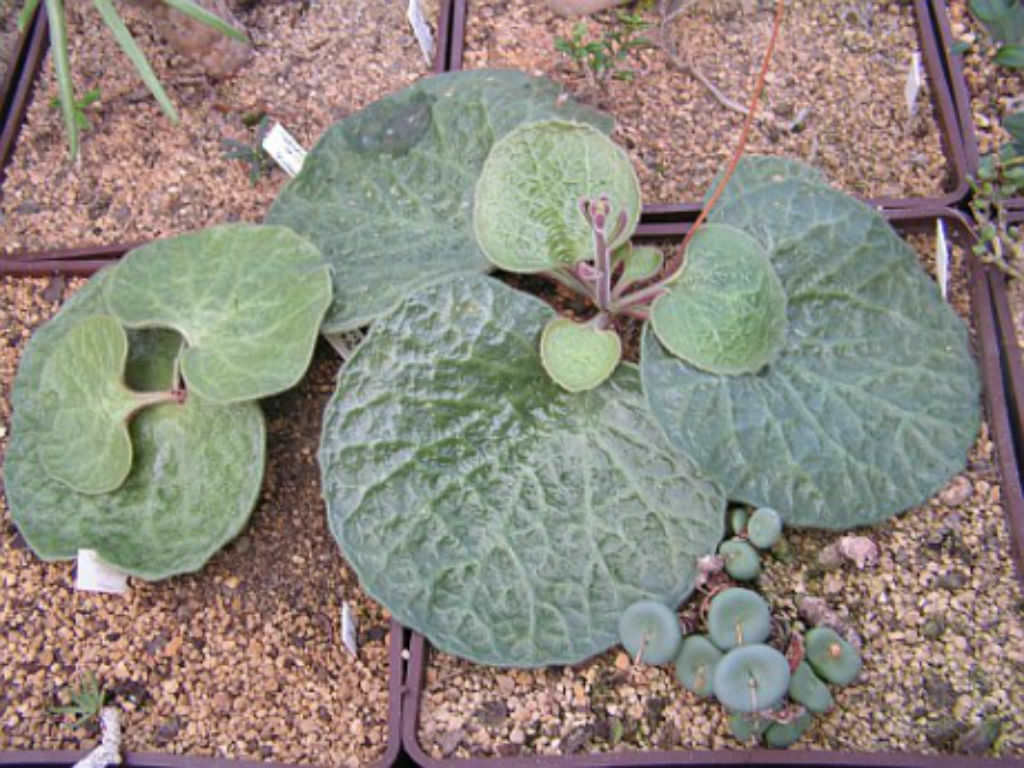Scientific Name
Tylecodon singularis (Dyer) Toelken
Synonym(s)
Cotyledon singularis
Scientific Classification
Family: Crassulaceae
Subfamily: Kalanchoideae
Genus: Tylecodon
Origin
This species is native to Namibia (found in a small area of Rosh Pinah).
Description
Tylecodon singularis is an unusual succulent geophyte with tuberous roots that usually produce one, rarely up to 4 fleshy leaves. The fusiform caudex grows up to 1.6 inches (4 cm) in diameter. Leaves are almost circular and up to 3.2 inches (8 cm) in diameter. They are glandular-hairy, green with paler veins, and purplish lower surface. Flowers appear in summer when the plant sheds its leaves on an up to 7.2 inches (18 cm) tall inflorescence. They are tubular, up to 0.5 inches (1.3 cm) long, and pale yellowish-green with short hairs.
Etymology
The specific epithet "singularis (sing-yoo-LAIR-iss)" is a Latin adjective meaning "alone" or "single" and probably refers to the usually solitary leaf of the plant.

How to Grow and Care for Tylecodon singularis
Light: This succulent can survive direct sunlight exposure without any problems, but it will grow beautifully in partial shade.
Soil: A well-draining soil mix is a key to healthy T. singularis. Poor drainage and overwatering most commonly cause root rot in both indoor and outdoor plants. Indoors, it is essential to use pots with at least one drainage hole at the bottom.
Hardiness: Like all Tylecodons, this succulent is highly tolerant when it comes to high temperatures and also tolerant of cold, frost-free conditions during the winter. T. singularis can withstand temperatures as low as 30 to 50 °F (-1.1 to 10 °C), USDA hardiness zones 10a to 11b.
Watering: As a winter grower, T. singularis requires careful watering during winter and spring. Get the soil wet, and then wait until it is dry before watering again. In summer, reduce watering to once per month.
Fertilizing: Use liquid fertilizer for cacti and other succulents during the winter months.
Repotting: You do not need to repot this plant often. You can do it when you see that the container becomes too small or shallow.
Propagation: T. singularis can be cultivated either by seed or by cuttings. Sow the seeds in fall and winter. The best time for taking cuttings is the fall.
Learn more at How to Grow and Care for Tylecodon.
Toxicity of Tylecodon singularis
T. singularis is adapted to avoid animal predation being poisonous. Therefore, keep it away from children, pets, and livestock.
Links
- Back to genus Tylecodon
- Succupedia: Browse succulents by Scientific Name, Common Name, Genus, Family, USDA Hardiness Zone, Origin, or cacti by Genus
Photo Gallery
Click on a photo to see a larger version.



